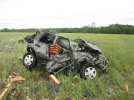If you're using the math that Ethan and the NTP paper established, you're assuming only horizontal wind components.So, just to be clear, calculate vertical and horizontal winds separately?
Navigation
Install the app
How to install the app on iOS
Follow along with the video below to see how to install our site as a web app on your home screen.
Note: This feature may not be available in some browsers.
More options
-
Welcome to TalkWeather! We see you lurking around TalkWeather! Take the extra step and join us today to view attachments, see less ads and maybe even join the discussion. CLICK TO JOIN TALKWEATHER
You are using an out of date browser. It may not display this or other websites correctly.
You should upgrade or use an alternative browser.
You should upgrade or use an alternative browser.
tornado examiner
Member
Unlikely. The Ashby Nebraska locomotive that was derailed earlier this year by the “EF2” in the sand hills. Weighed 220 ton’s and was likely stationary. Also note that many of the cars it derailed were dragged some distance away from the tracks.Oh wow! I didn't realize that. Definitely changes the picture a lot. Was the Nebraska train engine moving when it was tipped?
Newton's first law!
If tipped over grain car’s can be rated EF5. Surely an engine weighing twice as much as a single one of those can be as well right?
Quote from the enderlin survey “these analysis estimate potential winds speeds of about 230mph are needed to completely overturn a fully loaded grain hopper car.”
WeathermanLeprechaun
Member
Some intense car damage from the forgotten Chapman tornado on 6/11/08, this tornado could've certainly breached violent (EF4+) intensity.
Well, do we have enough proper detailed information to make a maths basis off it? Understandably like many have discussed, you only assume horizontal wind components with this. I'm not too sold on Ashby just yet, because Enderlin was kinda a exception and we really just can't assume every single non traditional DI fits automatically into Enderlin category or proves it was Enderlin eque. I'm happy to be proven wrong, the velocity data was certainly exceptional and essentially a high res Greensburg repeatUnlikely. The Ashby Nebraska locomotive that was derailed earlier this year by the “EF2” in the sand hills. Weighed 220 ton’s and was likely stationary. Also note that many of the cars it derailed were dragged some distance away from the tracks.
If tipped over grain car’s can be rated EF5. Surely an engine weighing twice as much as a single one of those can be as well right?
Quote from the enderlin survey “these analysis estimate potential winds speeds of about 230mph are needed to completely overturn a fully loaded grain hopper car.”
Attachments
Yeah 220 tons would be a little over 1.5 times the weight of a fully loaded grain car so that's definitely interesting.Unlikely. The Ashby Nebraska locomotive that was derailed earlier this year by the “EF2” in the sand hills. Weighed 220 ton’s and was likely stationary. Also note that many of the cars it derailed were dragged some distance away from the tracks.
If tipped over grain car’s can be rated EF5. Surely an engine weighing twice as much as a single one of those can be as well right?
Quote from the enderlin survey “these analysis estimate potential winds speeds of about 230mph are needed to completely overturn a fully loaded grain hopper car.”
WeathermanLeprechaun
Member
Cisco has been mentioned before in this thread and elsewhere but I'd like to remind this is another fairly questionable "EF3" from Texas once again. This isn't the worst damage i know of from Cisco but it is hard to dig up results with how useless Google or any search engine of that matter is nowadays. :/
Attachments
tornado examiner
Member
It is worth calculating which is why I'm hoping someone can do that.Yeah 220 tons would be a little over 1.5 times the weight of a fully loaded grain car so that's definitely interesting.
220 ton’s is no joke it's way more than any standard car. Even just knocking that over would surely require insane winds right?
Like when was the last time an actual locomotive was derailed by a tornado?
Cisco has been mentioned before in this thread and elsewhere but I'd like to remind this is another fairly questionable "EF3" from Texas once again. This isn't the worst damage i know of from Cisco but it is hard to dig up results with how useless Google or any search engine of that matter is nowadays. :/
- Messages
- 4,553
- Reaction score
- 9,243
- Location
- California, United States
- Special Affiliations
- SKYWARN® Volunteer
Minor correction, but that tornado was given a high-end EF3 rating. The train derailment WAS rated EF2, but the worst damage was to a farmhouse that was swept away.True. There's that well-known video of the Harvard, IL tornado of January, 2008 derailing a Union Pacific train (as it was in motion) and that tornado's EF2 rating is pretty non-controversial.
Another interesting tidbit about that particular tornado and the two others from that day (as I've mentioned before) is that they actually tracked over still frozen lakes and lingering patches of snow.
Ozonelayer
Member
After doing/revising/learning some math, I can test out the math on the Lake City tornado.
I did, and I got an answer of approximately 186 MPH (To be exact, 186.5) which is about 1 MPH off from Ethan's analysis via X.
I can conclude based off of both my and Ethan's math, that Lake City had EF-4 winds, and could/would have been rated as such if the same logic from Enderlin had applied.
I did, and I got an answer of approximately 186 MPH (To be exact, 186.5) which is about 1 MPH off from Ethan's analysis via X.
I can conclude based off of both my and Ethan's math, that Lake City had EF-4 winds, and could/would have been rated as such if the same logic from Enderlin had applied.
tornado examiner
Member
After doing/revising/learning some math, I can test out the math on the Lake City tornado.
I did, and I got an answer of approximately 186 MPH (To be exact, 186.5) which is about 1 MPH off from Ethan's analysis via X.
I can conclude based off of both my and Ethan's math, that Lake City had EF-4 winds, and could/would have been rated as such if the same logic from Enderlin had applied.
It's funny how easy it is to use the “other” Di and just, type in those numbers to make it official. But…you know. We all know lake city was a violent tornado.
tornado examiner
Member
The likelihood that nws little rock uses calculations from months after the fact not even done by one of their collaborators to retroactively upgrade a tornado from a vehicle that has long since been scrapped, even thought the math and science is sound.
Is next to zero.
Is next to zero.
Lake City was MEG. LZK has been really good as of late. See 3/14.The likelihood that nws little rock uses calculations from months after the fact not even done by one of their collaborators to retroactively upgrade a tornado from a vehicle that has long since been scrapped, even thought the math and science is sound.
Is next to zero.
Kds86z
Member
I remember after lake city happened some of us hoped it was LZK who would survey it because they did superb for 3/14 but nope MEG area. Some were skeptical….and sure enough ef3.
It has been a really good couple days for tornado science. I can't believe how quickly NWS Grand Forks managed to flip everything on its head. Feels like a total culture shift.
Also here's the full Tim Marshall interview
Pretty hilariously, the interviewer admits to trying to push Tim Marshall into giving a substantial answer about re rating previous tornadoes.
View attachment 47016
I mentioned it previously, but Ari and his producer are total tornado nerds. He had a segment with Trey from Convective Chronicles last month where they nerded out over his 2025 prediction video. I’m sure him and his producer are absolutely aware of the EF scale flaws. It’s really funny in hindsight just how pointed those tweets were that they were reading from.
Aaron Rider
Member
There's a big difference between just derailing on the one hand and, on the other hand, lofting the hell out of the train or cars and playing with them like toysSo, perhaps enderlin’s case really is the outlier among all tornado related derailment throughout history.
But if it really is that easy in most case’s than…i guess they’ll have too make a major distinction between loaded and unloaded car’s if they are too add rail cars as a Di in the revised EF-scale.
As well as the type of car.
SilentShadow87
Member
Derailment vs. actually lofting/tossing train cars is also a very important distinction to make. I wouldn't say derailing a loaded train car is necessarily a better indicator of a violent tornado than the long-distance movement of an unloaded train car (or any other large multi-ton object, for that matter).So, perhaps enderlin’s case really is the outlier among all tornado related derailment throughout history.
But if it really is that easy in most case’s than…i guess they’ll have too make a major distinction between loaded and unloaded car’s if they are too add rail cars as a Di in the revised EF-scale.
As well as the type of car.
Lake Martin EF4
Member
Gotta retract this: my memory of 6/20 is now more clear, and now I remember: I was in a hotel in Missouri which had an internet outage, so I went to sleep early, woke up at 2:00 AM the next day after the internet came back, and THEN found out about the tornado. I slept through the first EF5 in 12 years. FML.And, as a nice addendum: my entire weather career so far has been spent with the dream of one day tracking an EF5 in situ. Today, I learned that my dream has finally come true.
wolfywise
Member
What I think happened with Enderlin is that it lofted the tankers, broke them from the hitches, then whipped out away from the track. This broke free one of the tankers that preceeded to be lofted about 500 ft away from the rest of the cars. Given this likely happened in a few seconds, the violence of the action combined with the extreme winds is what then tipped over the grain hoppers (which I might add were pushed by the winds so forcefully it warped the track before they fell over).
WeathermanLeprechaun
Member
Thanks! Definitely shows this was certainly a violent tornado without question.
joshoctober16
Member
heavy metal tank thrown 1+ km away from the diaz tornado.
that loud jet roar it had along with sweeping a brick building really shows this is one they should have a relook at as well.


